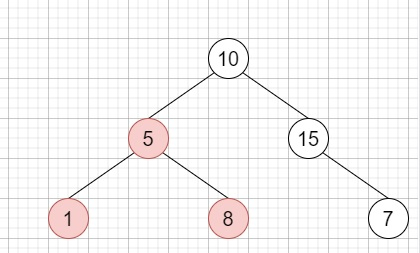
 Data Structure
Data Structure Networking
Networking RDBMS
RDBMS Operating System
Operating System Java
Java MS Excel
MS Excel iOS
iOS HTML
HTML CSS
CSS Android
Android Python
Python C Programming
C Programming C++
C++ C#
C# MongoDB
MongoDB MySQL
MySQL Javascript
Javascript PHP
PHP
- Selected Reading
- UPSC IAS Exams Notes
- Developer's Best Practices
- Questions and Answers
- Effective Resume Writing
- HR Interview Questions
- Computer Glossary
- Who is Who
Largest BST Subtree in C++
Suppose we have a binary tree; we have to find the largest subtree of it where largest means subtree with largest number of nodes in it.
So, if the input is like,

then the output will be 3, as the Largest BST Subtree, in this case, is the highlighted one.
To solve this, we will follow these steps −
Define one structure called data, there will be four values, size, maxVal, minVal, and ok, the ok can hold only true/false values
solve(TreeNode * node)
-
if node is null, then &miuns;
return Data by initializing (0, infinity, -infinity, true)
left := solve(left of node)
left := solve(right of node)
Define one data called curr
curr.ok := false
-
if val of node >= right.minVal, then −
return curr
-
if val of node <= left.maxVal, then −
return curr
-
if left.ok is true and right.ok is true, then −
curr.sz := 1 + left.sz + right.sz
curr.ok := true
curr.maxVal := maximum of (val of node and right.maxVal)
curr.minVal := maximum of (val of node and left.minVal)
-
if curr.ok is true, then −
ret := maximum of ret and curr.sz
return curr
From the main method, do the following −
ret := 0
solve(root)
return ret
Example
Let us see the following implementation to get a better understanding −
#include <bits/stdc++.h>
using namespace std;
class TreeNode{
public:
int val;
TreeNode *left, *right;
TreeNode(int data){
val = data;
left = NULL;
right = NULL;
}
};
void insert(TreeNode **root, int val){
queue<TreeNode*> q;
q.push(*root);
while(q.size()){
TreeNode *temp = q.front();
q.pop();
if(!temp->left){
if(val != NULL)
temp->left = new TreeNode(val);
else
temp->left = new TreeNode(0);
return;
}
else{
q.push(temp->left);
}
if(!temp->right){
if(val != NULL)
temp->right = new TreeNode(val);
else
temp->right = new TreeNode(0);
return;
}
else{
q.push(temp->right);
}
}
}
TreeNode *make_tree(vector<int< v){
TreeNode *root = new TreeNode(v[0]);
for(int i = 1; i<v.size(); i++){
insert(&root, v[i]);
}
return root;
}
struct Data{
int sz;
int maxVal;
int minVal;
bool ok;
Data(){}
Data(int a, int b, int c, bool d){
sz = a;
minVal = b;
maxVal = c;
ok = d;
}
};
class Solution {
public:
int ret;
Data solve(TreeNode* node){
if (!node)
return Data(0, INT_MAX, INT_MIN, true);
Data left = solve(node->left);
Data right = solve(node->right);
Data curr;
curr.ok = false;
if (node->val >= right.minVal) {
return curr;
}
if (node->val <= left.maxVal) {
return curr;
}
if (left.ok && right.ok) {
curr.sz = 1 + left.sz + right.sz;
curr.ok = true;
curr.maxVal = max(node->val, right.maxVal);
curr.minVal = min(node->val, left.minVal);
}
if (curr.ok)
ret = max(ret, curr.sz);
return curr;
}
int largestBSTSubtree(TreeNode* root){
ret = 0;
solve(root);
return ret;
}
};
main(){
Solution ob;
vector<int< v = {10,5,15,1,8,NULL,7};
TreeNode *root= make_tree(v);
cout << (ob.largestBSTSubtree(root));
}
Input
[10,5,15,1,8,null,7]
Output
3

